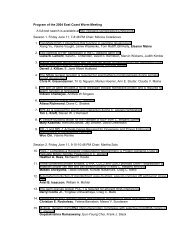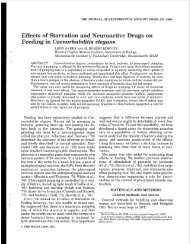West Coast Worm Meeting Abstracts - Caenorhabditis elegans ...
West Coast Worm Meeting Abstracts - Caenorhabditis elegans ...
West Coast Worm Meeting Abstracts - Caenorhabditis elegans ...
Create successful ePaper yourself
Turn your PDF publications into a flip-book with our unique Google optimized e-Paper software.
ROLES OF OSM-9/CAPSAICIN RECEPTOR FAMILY<br />
MEMBERS IN SENSORY BEHAVIORS<br />
D. Tobin 1 , D. Madsen 2 , G. Moulder 3 , R. Barstead 3 , A.V. Maricq 2 , M.<br />
deBono 4 , C. Bargmann 1<br />
1University of California San Francisco, HHMI<br />
2University of Utah<br />
3Oklahoma Medical Research Foundation<br />
4MRC, Cambridge<br />
<strong>West</strong> <strong>Coast</strong> <strong>Worm</strong> <strong>Meeting</strong> 2000<br />
The osm-9 gene is required for a wide range of sensory modalities in C. <strong>elegans</strong> including<br />
chemosensation, mechanosensation, osmosensation, and certain forms of olfactory adaptation. osm-9<br />
encodes a putative ion channel with striking homology to the vertebrate capsaicin receptor, a cation<br />
channel expressed in pain-sensing neurons and gated by the active component of chili peppers. In the<br />
amphid neuron AWA, OSM-9 localizes to sensory cilia, suggesting a direct role in sensory transduction.<br />
The vertebrate capsaicin receptor VR1 responds to heat, capsaicin, and low pH. Expression of<br />
mamamlian VR1 under an AWA-specific promoter partially rescued osm-9’s AWA defects. Thus, the<br />
homology between the two proteins may have functional relevance. However, OSM-9 is not sensitive to<br />
capsaicin. We found that expression of mammalian VR1 in C. <strong>elegans</strong> nociceptive neurons created a<br />
robust capsaicin-avoidance behavior. Heterologous expression of VR1 should be a useful tool for specific,<br />
drug-inducible neuronal activation.<br />
Four relatives of osm-9 are each expressed in subsets of osm-9-expressing cells. We call these genes<br />
ocr (osm-9/capsaicin receptor-related)genes and have generated mutations in two of them. ocr-1 is<br />
expressed primarily in AWA while ocr-2 is expressed in AWA, ASH, ADL, and ADF. Based on their<br />
expression patterns and similarity to osm-9 we hypothesized that the OCR channels might coassemble<br />
with OSM-9 to form heteromultimeric complexes. Mutations in ocr-2 recapitulate some of osm-9’s defects:<br />
there are dramatic defects in AWA-mediated chemotaxis and ASH-mediated avoidance behaviors. We<br />
propose that different combinations of subunits may account for the distinct functions of osm-9 in different<br />
sensory neurons.<br />
Interestingly, ocr-2 has a role in C. <strong>elegans</strong> social behavior. npr-1 encodes a putative neuropeptide<br />
receptor that regulates the choice between solitary and social foraging behavior. osm-9 and ocr-2 mutants<br />
suppress the clumping behavior of npr-1 mutants. We have performed single-cell rescue experiments to<br />
identify the neurons in which ocr-2 expression is required for social behavior. Identification of these<br />
neurons should help define the sensory signals and neuronal circuitry that mediate clumping.<br />
30




